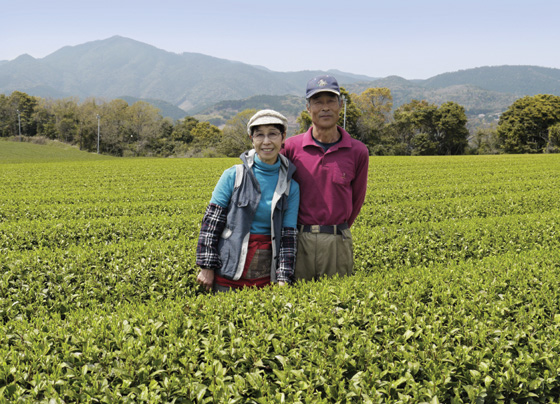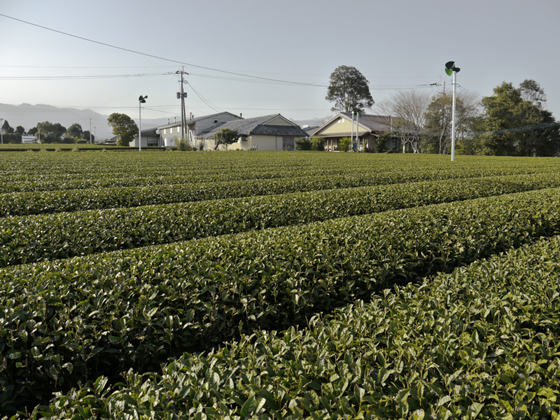- You do not have any products in your shopping cart yet.








The particularly fine leaves from the shrub type Minami Sayaka are exclusively ground to fine powder. Before this, the shrubs are kept in shade under black nets for approximately 2 weeks. Haruyo and Shigeru Morimoto have selected these shrub type for their special Matcha due to the intensive green colour, special fruity fragrance and the fine sweetness. Due to the longer shadowing, these qualities of Minami Sayaka emerge as special.
Only 10 kilogrammes of this tea are produced per year. Due to the high-value qualityof this Matcha, our stored stock is limited.
Only 10 kilogrammes of this tea are produced per year. Due to the high-value qualityof this Matcha, our stored stock is limited.
50 gram pouch
Eco control point DE-ÖKO-039
Eco control point DE-ÖKO-039
Information about the tea garden of Morimoto family
The bio-tea garden of the Morimoto family is on the most southern of the four main islands of Japan, not far from the city Miyazaki, in the prefecture of the same name.

The history of the Morimoto green tea began as the young couple founded a tiny company about forty years ago with a single, small tea garden. As the Morimotos developed into a perfect team over the years, the size of the company grew as did their experience in tea cultivation. Nowadays they manage twelve tea garden areas together and have their own production hall, which they operate almost exclusively together. During the harvest phase, tea plucker friends or also the children sometimes help in the processing.
One of many specific features of the Morimotos is that they cultivate a total of seven different tea-shrub types: Yabukita, Kanaya Midori, Oku Midori, Oku Yutaka, Minimi Sayaka, Sakimidori, and also the Assamica hybrid Benifuki. There are many different shrub types, and recently also another strain, which will possibly be the basis for the first tea of a quite a new type for a few years. This is because by mixing the leaves of different shrub types, different flavored grades of green tea are possible, which can finally be enjoyed..
Moreover, many tea shrub types also present a remarkable concept for the Morimotos: Beside their flavor-related features, different shrub types also have different qualities, that is, how they react to the climate and to pests like insects. If a shrub type is especially affected for any reason in one year, possibly by the infestation of a certain pest, then this does not signify directly the failure of the harvest in the other sections of the Morimotos‘ tea project where there are other tea shrubs. The many shrub types are also demonstrate Morimotos‘ preference for diversity.
The fact that the Morimotos think about such issues, is not unusual for Japanese “bio-farmers”. In the end, they produce “Bio” not because they hope for higher profits , or better sales opportunities, but because they look at it as a valuable purpose to grow natural tea in surroundings characterised by ecological balance.

(Here, it is not real Matcha in the literal sense, because this product is produced not from overshadowed Tencha, but from Sencha. Still we have this product on offer, because it lends itself very well in the production of mixed drinks or as cooking Matcha)

The history of the Morimoto green tea began as the young couple founded a tiny company about forty years ago with a single, small tea garden. As the Morimotos developed into a perfect team over the years, the size of the company grew as did their experience in tea cultivation. Nowadays they manage twelve tea garden areas together and have their own production hall, which they operate almost exclusively together. During the harvest phase, tea plucker friends or also the children sometimes help in the processing.
One of many specific features of the Morimotos is that they cultivate a total of seven different tea-shrub types: Yabukita, Kanaya Midori, Oku Midori, Oku Yutaka, Minimi Sayaka, Sakimidori, and also the Assamica hybrid Benifuki. There are many different shrub types, and recently also another strain, which will possibly be the basis for the first tea of a quite a new type for a few years. This is because by mixing the leaves of different shrub types, different flavored grades of green tea are possible, which can finally be enjoyed..
Moreover, many tea shrub types also present a remarkable concept for the Morimotos: Beside their flavor-related features, different shrub types also have different qualities, that is, how they react to the climate and to pests like insects. If a shrub type is especially affected for any reason in one year, possibly by the infestation of a certain pest, then this does not signify directly the failure of the harvest in the other sections of the Morimotos‘ tea project where there are other tea shrubs. The many shrub types are also demonstrate Morimotos‘ preference for diversity.
The fact that the Morimotos think about such issues, is not unusual for Japanese “bio-farmers”. In the end, they produce “Bio” not because they hope for higher profits , or better sales opportunities, but because they look at it as a valuable purpose to grow natural tea in surroundings characterised by ecological balance.

(Here, it is not real Matcha in the literal sense, because this product is produced not from overshadowed Tencha, but from Sencha. Still we have this product on offer, because it lends itself very well in the production of mixed drinks or as cooking Matcha)

1-2 gram / 300ml

maximum 80° C / 176° F

Eco control point: DE-ÖKO-007
Responsible food business operator:
Marimo GmbH, Muenchener Str. 45, 60329 Frankfurt am Main
4,5
All reviews in our store come from real customers who have bought the product and were given voluntarily by customers without any consideration.
Unfortunately there are no review yet. Be the first who rate this product.
All reviews in our store come from real customers who have bought the product and were given voluntarily by customers without any consideration.
You must be logged in to submit a review. Login






.jpg)

.jpg)












































_1406_2.jpg)
